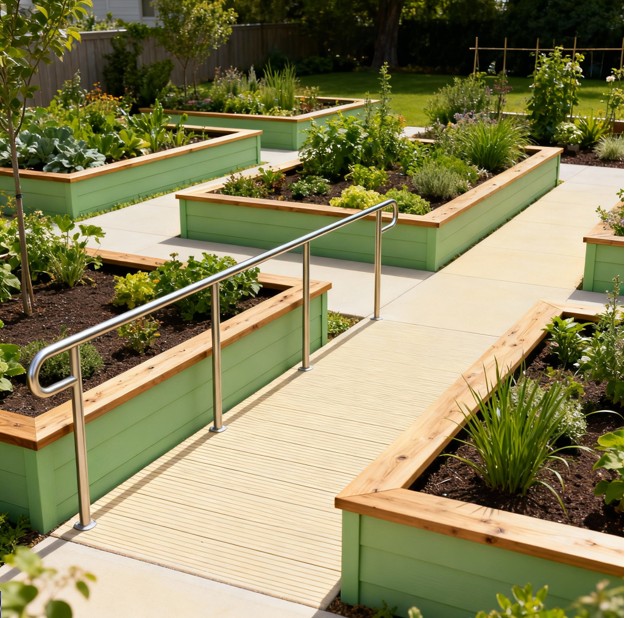Remember when gardening meant spending entire Saturday mornings on your hands and knees, wrestling with stubborn weeds and hauling heavy bags of mulch? Those days don’t have to disappear just because the calendar pages keep turning. Smart landscaping design services and residential landscaping design approaches are revolutionizing how mature homeowners can maintain their connection to the earth without the physical strain that once seemed inevitable. Today’s commercial landscaping design principles, adapted for residential use, create outdoor sanctuaries that support independence while celebrating the beauty of well-lived experience.
 The intersection of accessibility and beauty has never been more sophisticated than in today’s smart homeowner transformation approaches. Forward-thinking homeowners are discovering that age-friendly landscaping doesn’t mean sacrificing style or settling for institutional-looking modifications. Instead, these thoughtful design solutions enhance both functionality and aesthetic appeal, creating outdoor spaces that feel like natural extensions of comfortable living rather than medical accommodations. Research from Better Homes & Gardens accessibility studies shows that well-designed accessible landscapes can increase property values while dramatically improving quality of life for residents of all ages.
The intersection of accessibility and beauty has never been more sophisticated than in today’s smart homeowner transformation approaches. Forward-thinking homeowners are discovering that age-friendly landscaping doesn’t mean sacrificing style or settling for institutional-looking modifications. Instead, these thoughtful design solutions enhance both functionality and aesthetic appeal, creating outdoor spaces that feel like natural extensions of comfortable living rather than medical accommodations. Research from Better Homes & Gardens accessibility studies shows that well-designed accessible landscapes can increase property values while dramatically improving quality of life for residents of all ages.
The Psychology of Staying Connected to Your Outdoor Space
There’s something profound that happens when we maintain our connection to outdoor spaces as we age. It’s like having a favorite armchair that has molded perfectly to your body over the years, except this chair is your entire backyard, and it continues to offer new discoveries with each season. The therapeutic benefits of gardening and outdoor living don’t diminish with age; they actually become more valuable as sources of purpose, gentle exercise, and mental stimulation.
The key lies in understanding that accessible doesn’t mean institutional. Modern landscape design for mature homeowners focuses on creating spaces that feel inviting and natural while incorporating smart modifications that reduce physical strain. Raised garden beds positioned at optimal heights eliminate the need for bending and kneeling, while wide, slip-resistant pathways provide confidence for those using mobility aids or simply wanting extra stability.
Container gardening has emerged as a game-changer for many seniors, offering the satisfaction of nurturing plants without the demands of traditional ground-level gardening. These elevated growing systems can be positioned at various heights to accommodate different comfort levels and mobility needs, transforming what might have been a frustrating limitation into an opportunity for creative garden design.
Creating Pathways That Welcome Rather Than Restrict
The magic of accessible pathway design lies in making navigation feel effortless rather than engineered. Think of your pathways as the circulation system of your outdoor space – they need to flow naturally while providing safe passage throughout your garden sanctuary. Modern accessibility standards recommend pathway widths of at least 48 inches, but the most successful designs go beyond mere measurements to create routes that feel generous and inviting.
Surface materials play a crucial role in both safety and aesthetics. Interlocking pavers and natural stone with textured finishes provide excellent traction in wet conditions while maintaining elegant appearances that complement any architectural style. These materials age gracefully, developing character over time rather than showing wear and deterioration.
Strategic rest areas positioned along pathways transform longer walks into manageable journeys punctuated by opportunities to pause and appreciate different garden vistas. Built-in seating or strategically placed benches serve dual purposes as functional rest stops and design elements that create focal points within the landscape composition.
Raised Beds: Bringing the Garden to You
The revolution in raised bed gardening has transformed how mature homeowners approach growing their own flowers, herbs, and vegetables. These elevated growing systems eliminate the physical demands of traditional ground-level gardening while creating organized, manageable growing spaces that actually enhance the overall landscape design.
Optimal height selection makes all the difference between a raised bed that truly serves its purpose and one that simply looks pretty. Heights between 24 and 30 inches work well for most seated gardeners, while 32 to 36-inch heights accommodate standing work with minimal bending. Some innovative designs incorporate varying heights within the same bed system, creating terraced effects that add visual interest while serving different functional needs.
Built-in tool storage and water access transform raised beds from simple planting containers into complete gardening workstations. These thoughtful additions eliminate the need to carry tools and watering supplies back and forth, reducing physical strain while encouraging more frequent interaction with plants.
Lighting That Extends Your Outdoor Hours Safely
As we age, our vision adapts, and outdoor lighting becomes less about ambiance and more about safety without sacrificing beauty. The most successful lighting designs layer different types of illumination to create environments that feel welcoming during evening hours while providing the visibility needed for confident navigation.
Path lighting serves as the foundation of any good outdoor lighting plan, but the key lies in selecting fixtures that provide even illumination without creating harsh shadows or glare. LED pathway lights with warm color temperatures create inviting atmospheres while offering energy efficiency and long service life that reduces maintenance demands.
Task lighting around seating areas, raised beds, and gathering spaces extends the usability of outdoor areas into evening hours. Solar-powered options eliminate the need for complex electrical installations while providing reliable illumination that automatically adjusts to seasonal daylight patterns.
Sensory Gardens: Engaging All the Senses Safely
Creating outdoor spaces that engage multiple senses enhances the therapeutic benefits of spending time outdoors while accommodating various physical abilities. Fragrant plants positioned near seating areas provide aromatherapy benefits without requiring close inspection, while textured foliage offers tactile interest for those who enjoy touching plants.
Sound elements like gentle water features or wind chimes add auditory interest that doesn’t overwhelm conversation but provides pleasant background ambiance. These elements work particularly well for individuals with vision limitations, creating audio cues that help with navigation and spatial awareness.
Edible landscaping brings practical benefits to sensory garden design. Herb gardens positioned within easy reach of seating areas allow for harvesting fresh seasonings without extensive walking, while berry bushes and fruit trees provide seasonal treats that can be enjoyed directly from the plant.
Weather Protection That Doesn’t Sacrifice Style
Ontario’s variable climate demands outdoor spaces that remain comfortable and usable throughout extended seasons. Covered seating areas and pergolas provide protection from sun and light precipitation while creating defined outdoor rooms that feel like extensions of indoor living space.
Retractable awnings offer flexibility for changing weather conditions without the permanent visual impact of fixed roofing structures. These systems allow homeowners to customize their level of weather protection based on daily conditions and seasonal preferences.
Strategic plant placement can provide natural climate control through shade trees positioned to block harsh afternoon sun and evergreen windbreaks that reduce cold winter winds. These living climate control systems improve comfort while contributing to the overall landscape aesthetics.
Technology Integration for Easier Maintenance
Modern landscape technology offers solutions that reduce maintenance demands without compromising garden health or beauty. Automated irrigation systems with weather sensors ensure plants receive optimal water levels while eliminating the physical demands of manual watering routines.
Smart plant selection focuses on native species and low-maintenance varieties that thrive in local conditions with minimal intervention. These plants typically require less water, fertilizer, and pest management while providing habitat for local wildlife and supporting ecological health.
Mulching strategies using organic materials help retain soil moisture, suppress weeds, and improve soil health over time. Proper mulching reduces the frequency of maintenance tasks while creating neat, finished appearances that enhance overall landscape aesthetics.
Social Spaces That Encourage Connection
Outdoor design for mature homeowners should prioritize spaces that encourage social interaction and community building. Conversation areas with comfortable seating arrangements create natural gathering spots where family and friends feel welcome to linger and connect.
Multi-generational design elements ensure that outdoor spaces accommodate visitors of all ages and abilities. Level access from indoor spaces, multiple seating options, and activity areas that don’t require specialized equipment create environments where everyone can participate comfortably.
Seasonal adaptability ensures that social spaces remain inviting throughout the year. Fire features extend outdoor gathering seasons into cooler months, while shade structures provide comfort during hot summer days.
Budget-Conscious Implementation Strategies
Creating accessible outdoor spaces doesn’t require complete landscape overhauls or unlimited budgets. Phased implementation allows homeowners to prioritize the most impactful changes first while spreading costs over multiple seasons.
DIY-friendly modifications like container gardens, portable seating, and solar lighting can provide immediate improvements while homeowners plan larger projects. These smaller changes often generate enthusiasm and confidence for more extensive modifications.
Professional consultation for initial planning can prevent costly mistakes while ensuring that incremental changes work together toward a cohesive long-term vision. Many landscape professionals offer design services that can be implemented gradually as budgets allow.
The beauty of thoughtful landscape design for mature homeowners lies in its dual nature: these modifications improve daily life while creating spaces that are genuinely more beautiful and interesting than conventional landscapes. When accessibility and aesthetics work together, the result isn’t compromise – it’s enhancement. Your garden’s golden years can truly be its most magnificent, offering comfort, beauty, and connection that enrich every season of life.
The investment in accessible landscaping pays dividends that extend far beyond mere convenience. These thoughtful modifications support independence, encourage social connection, and create therapeutic environments that contribute to overall health and wellbeing. Most importantly, they ensure that your relationship with your outdoor space can continue to flourish and evolve, regardless of changing physical capabilities.






